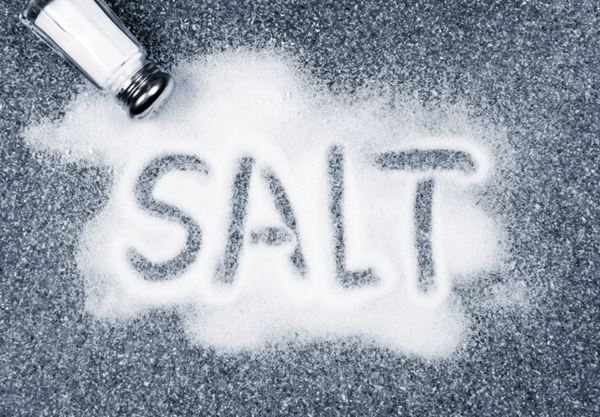A food preservative is something added to foods to make them last longer; to “preserve” them. Preservatives are added to foods that go bad quickly and have found themselves in all kinds of products in our grocery stores these days.
Preservatives work to preserve food in a few different ways. There are so many preservatives out there. Some prevent the growth of bacteria and mold and others prevent delicate fats from going rancid. And while preservatives added to foods should be “approved,” this doesn’t mean they’re guaranteed to be safe and it doesn’t mean that the food is healthy.
Foods containing preservatives are more-processed, less-nutritious foods to begin with – not exactly health foods. So, even if you don’t mind preservatives you might want to cut down on these foods.
Okay, now let’s take a look at a few of the more common food preservatives.
Salt
That’s right – salt.
FUN FACT: The term “salary” is from the Latin word for salt. It’s thought that it came from the ancient Romans who would pay employees, allowing them to buy salt. Either that, or it was for their work conquering and/or guarding salt mines/roads. Either way, salt was sought because of its ability to preserve food before the advent of refrigeration.

Nowadays, with fridges and freezers available everywhere, salt is not as needed for food preservation. However, our taste buds still seem to crave it on an epic scale! The average American eats over 3,400 mg of sodium per day, well over the recommended 2,300 mg/day. Much of that is because it’s found in all of our processed foods.
According to Harvard Health:
“… reducing dietary salt (table salt that is only sodium, chloride and iodine) will lower blood pressure, reduce the risk of heart attack and stroke, and save lives.”
Salt is one of those way-too-common food preservatives that most of us would do far better with less of.
Nitrites (nitrates and nitrosamines)
Nitrites are preservatives added to processed meats and while they’re not bad in and of themselves, they turn into harmful chemicals called nitrosamines which are not so great. Nitrosamines are carcinogens and are found in cigarette smoke. Nitrites form nitrosamines when they’re cooked at high heat, and sometimes even when simply exposed to the high acid environment of the stomach.
Nitrites are added to meats in order to keep the pink-red colour and prevent “browning” commonly in bacon, ham, sausages and lunch meats. Since nitrites can change into nitrosamines, nitrites are one-step away from being the “bad guys.”
 It is worth knowing that processed meats have also been linked with colon cancer. Is it because of the nitrites? Perhaps. But either way, nitrosamines are a confirmed health-buster.
It is worth knowing that processed meats have also been linked with colon cancer. Is it because of the nitrites? Perhaps. But either way, nitrosamines are a confirmed health-buster.
Since nitrosamines (from nitrites) are the bad guys and are formed by cooking nitrites at high heat, what are nitrates?
Nitrates are actually found naturally in many healthy foods like vegetables. (They’re especially high in beets!) Sometimes our enzymes or gut bacteria change these healthy nitrates into nitrites. However, they rarely form nitrosamines because they’re two-steps away from becoming these “bad guys.”
BHA & BHT
Have you seen on packaged food that “BHA/BHT has been added to the package to help maintain freshness?” Perhaps on cereal packages or in gum? Guess how these compounds maintain freshness? It’s because they’re preservatives.
 BHA (butylated hydroxyanisole) and BHT (butylated hydroxytoluene) are antioxidants added to many processed foods. The main way BHA and BHT work is by preventing fats from going rancid.Are they safe? Well, they’re approved for use as a preservative at small doses. It in concerning that some studies show they can cause cancer in animals at high doses. Again, they’re added to processed pre-packaged foods, so it’s wise to avoid them nonetheless. Oh, and you can also learn more about reading those pesky nutrition labels over here.
BHA (butylated hydroxyanisole) and BHT (butylated hydroxytoluene) are antioxidants added to many processed foods. The main way BHA and BHT work is by preventing fats from going rancid.Are they safe? Well, they’re approved for use as a preservative at small doses. It in concerning that some studies show they can cause cancer in animals at high doses. Again, they’re added to processed pre-packaged foods, so it’s wise to avoid them nonetheless. Oh, and you can also learn more about reading those pesky nutrition labels over here.
Conclusion
There are so many preservatives in our food supply, largely in processed foods. These compounds work by preventing the growth of bacteria and mold, or by preventing fats from going rancid. If you want to avoid them: Eat fresh foods.
Does this information make you want to read all your food ingredient labels now? Let me know in the comments below.
Like what you read? Be sure to join our super-awesome health newsletter mailing list!!
Recipe (preservative-free): Kale Chips (Serves 4)
1 bunch of kale, washed and dried
1 tbsp olive oil
2 dashes salt
2 dashes garlic powder
Instructions
- Preheat oven to 300F and place a sheet of parchment paper on a baking sheet.
- Take the washed and dried kale and rip them into “chip” size pieces and place in a large bowl.
- Drizzle with olive oil, salt, and garlic powder. Mix until the kale pieces are evenly covered.
- Place kale onto prepared sheet in an even layer. Bake for 10 minutes.
- Flip over the kale to cook the other sides of the pieces. Bake for another 10 minutes until the edges just start turning brown. Monitor them well, or you’ll have burnt kale chips.
- Serve & enjoy!
Tip: You can use any spice, so try onion powder, paprika, or even turmeric.



